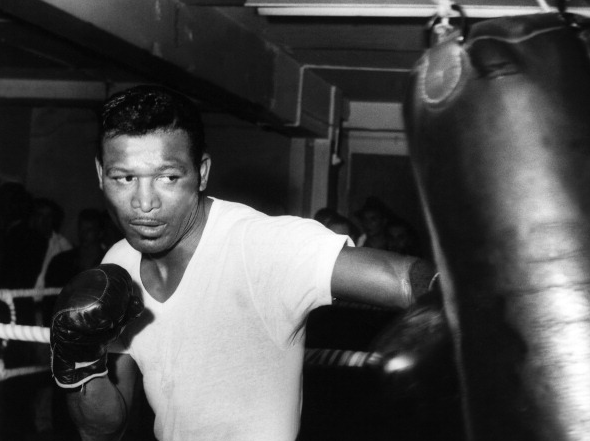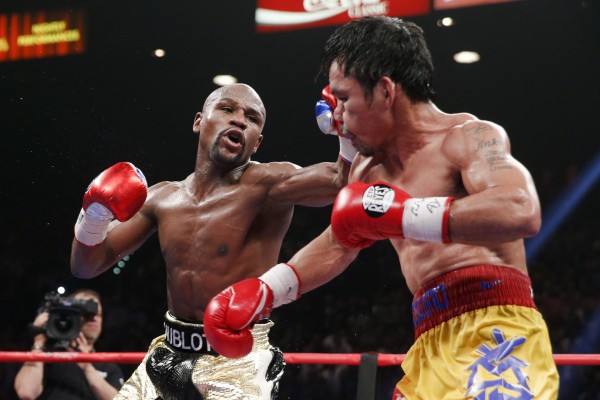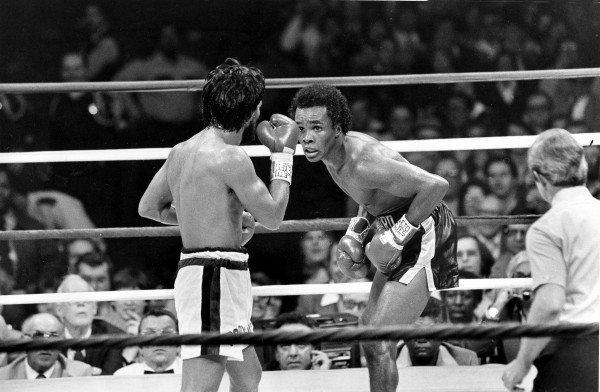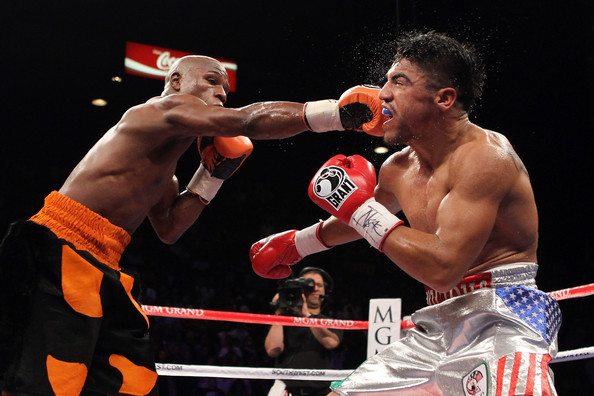
Photo by Al Bello/Getty Images
Simply thinking of 10 great welterweights is not overtly difficult, but filtering them exclusively to Americans eliminates some of the obvious choices and becomes much more challenging.
For example:
Ted “Kid” Lewis: (233-41-25, 80 KOs) – England
Jimmy McLarnin: (55-11-3, 21 KOs) – Ireland
Emile Griffith: (85-24-2, 23KOs) – Virgin Islands
Jose Napoles: (81-7, 54 KOs) – Cuba
Kid Gavilan: (108-30-5, 28 KOs)- Cuba
Joe Walcott: (95-25-24, 61 KOs)- Barbados
Luis Rodriguez: (107-13, 49 KOs) – Cuba
From our Founding Fighting Forefathers to the Magnificent Modern Maulers the following is a 10 bell salute to the very best American born 147 pounders ever to liberate an opponent from their senses.
10. Oscar De La Hoya
39-6, 30 KOs
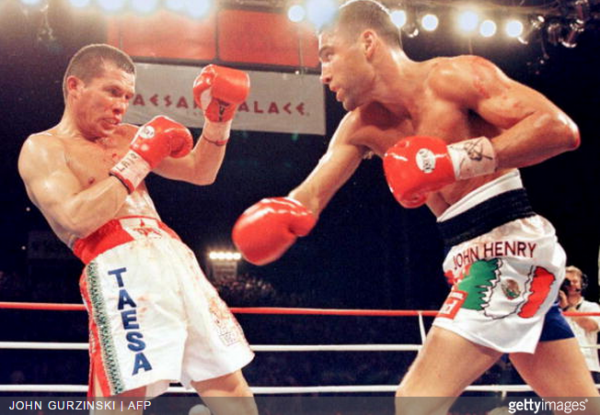
Birthplace: Montabello, CA
Professional Career: 1992-2008
1972 was a busy year as the U.S. involvement in the Vietnam War ends, the Sears Tower in Chicago is completed, the Drug Enforcement Agency (D.E.A.) is formed, the Watergate scandal erupts and a Golden Boy was born.
Oscar De La Hoya had an outstanding amateur career, amassing a record of 234-6, 163 KOs with two of those losses coming against future professional nemesis Shane Mosley.
In the 1992 Olympics in Barcelona, Spain, De La Hoya fulfilled a promise made to his terminally ill mother when he defeated Marco Rudolph of Germany to bring the gold medal home to America.
De La Hoya had already developed an excellent professional career before embarking on his welterweight journey winning titles in the super featherweight, lightweight and super lightweight divisions.
In his first fight at 147, he unseated the defensive wizard Pernell Whitaker (40-1-1, 17 KOs) for the WBC strap winning by a very close, but unanimous decision.
After four defenses including a wide unanimous decision over the slippery Hector “Macho” Camacho, De La Hoya squared off in a rematch with Mexican legend Julio Cesar Chavez (100-2-2, 81 KOs) who he had defeated two years prior at 139 pounds.
In a clash of Mexican American vs. Mexican, De La Hoya dismantled the great Chavez and opened a huge gash over his eye that covered his face in a gory mask of blood, finally forcing him to retire on his stool in Round 8.
De La Hoya went to war with the always tough Ike Quartey (34-0-1, 29 KOs) in his next successful defense, and then set his sights on Puerto Rican puncher Felix Trinidad (35-0, 30 KOs) in a super fight that he lost via a controversial 12-round decision.
In 2001, De La Hoya notched his last win at welterweight against the human highlight reel, Arturo “Thunder” Gatti (40-9, 31 KOs), via fourth-round stoppage before moving up in weight and further enhancing an already storied career.
Greatest rival: De La Hoya didn’t fight any welterweight rematches, however his bout with Chavez when he moved up to face the Golden Boy was certainly one taken personally by both fighters.
9. Jack Britton
103-29-20, 30 KOs
Birthplace: Clinton, New York
Professional Career: 1904-1930
“The Boxing Marvel,” Jack Britton was born on October of 1885 and originally named William J. Breslin. Outlaw Billy the Kid had been killed just four years earlier and it would be 23 years before the Ford Model T would go into production.
Jack Britton became the type of fighter for which stories are written and legends are inspired. This actually manifests itself in the literal sense in the short story “Fifty Grand” by Ernest Hemmingway which is based on his 1922 bout with fellow fabled fighter “The Toy Bulldog,” Mickey Walker in Madison Square Garden.
Britton’s final boxing record has been registered with inconsistencies, not completely uncommon with a fighter from that early American generation. The above mentioned record appears to be credible however there are accounts of his final ledger as 213-52-43 and 239-57-44.
These were the early dusty days when combatants would often fight many times a year, in fact even several times in a month; far away from a time rife with network deals, fat contracts and protected records. Living fight to fight was the boxer’s far more dangerous equivalent to everyday people living check to check. For the true gladiators of this time, eating meant fighting anyone and often.
Britton was clearly able to forge a living in the unforgiving blood sport with a career that spanned 25 years. He competed in an amazing 37 title bouts, a historic landmark that stands to this day as the most in boxing history.
While it would appear that Britton was a master boxer without a huge payoff punch, he fought his way to the top of his game becoming a three-time Welterweight champion of the world.
Greatest rival: Britton engaged in 20 battles with fellow Hall of Famer, Ted “Kid” Lewis, many of which were title bouts.
8. Floyd Mayweather Jr.
48-0, 26 KOs
Birthplace: Grand Rapids, Michigan
Professional Career: 1996-Present
In 1977 the American national average cost for a house was $13,650, a new BMW 320i was $7990, gas was .65 per gallon and the only active fighter to appear on this list, Floyd Joy Mayweather Jr. was born.
That Floyd Mayweather has fought only 13 times in the welterweight division and still rate so highly is a testament to the dominance and amazing defensive prowess that he has displayed.
Despite widespread criticism to the contrary, one doesn’t win enough significant fights to become recognized as the best fighter of his generation without an effective offense as well. Effective doesn’t necessarily mean exciting and the very word exciting is subjective to the individual.
Mayweather’s maiden voyage into the welterweight division came via sixth-round stoppage victory over former IBF super lightweight champion Sharmba Mitchell in November of 2005.
Each of the 12 subsequent fights in which Mayweather participated from that time forward came against either a former or current world champions.
Mayweather won the IBF welterweight championship in his next bout against the crafty Brooklyn, NY southpaw Zab Judah by a wide 12-round unanimous in Las Vegas, Nevada.
He continued on his quest to unify the welterweight titles in his next fight by challenging rugged Argentine Carlos Baldomir for the WBC championship in what was a career high payday for both at that time. Mayweather took complete control and the fight was not competitive from the opening bell, which elicited boos from the crowd with many leaving the arena before the decision was announced.
It was Mayweather’s next fight against Oscar De La Hoya that he emerged into mainstream America’s full vision in what was the highest grossing non-heavyweight fight to that point.
In contrast to most of Mayweather’s fights, this one provided its share of two-way action. While his amazing defense and patented shoulder roll were on full display, De La Hoya used his jab effectively enough for the first half of the fight to keep things interesting.
One of Mayweather’s trademark weapons came into play as his general boxing IQ allowed him to make the proper adjustments and outpoint the challenger over 12 hard-fought rounds.
He defended his title five times and picked up the WBA super welterweight championship from Miguel Cotto before buzz built for a fight against the young, undefeated Mexican superstar Saul “Canelo” Alvarez.
Supporters of the immensely popular Alvarez expected him to give Mayweather all he could handle and wrestle not only the title but the “0” from his record as well.
They went home disappointed as Mayweather virtually shut out Alvarez over 12 one-sided rounds, cruising to what somehow was a majority decision victory in a fight not nearly as close as the cards suggested.
Mayweather put his titles on the line next against hard punching Marcos “Chino” Maidana in what was thought to be a relatively safe defense.
Maidana came to fight, however, attacking Mayweather aggressively and using all tools at his disposal within the rules and beyond.
In what was Mayweather’s most competitive fight in years he emerged with a 12-round majority decision victory which he improved upon in the rematch, capturing a unanimous decision in an ugly affair.
For six years a potential mega fight against Filipino national hero and boxing sensation Manny Pacquiao bubbled and brewed like an unstable volcano with no one knowing when or even if it would explode.
After countless roadblocks were finally overcome, Mayweather took on Pacquiao in what became the richest fight in boxing history, generating revenue reputed to be close to half a billion dollars. Needless to say both fighters walked away with a career-high payday.
It would be impossible for any fight to live up to the buildup that was Mayweather v Pacquiao, but to say this one fell short would be a vast understatement.
Mayweather won a unanimous decision as the usually aggressive Pacquiao was uncharacteristically unable to cut off the ring or put himself in position to throw the blazing fast combinations from unpredictable angles which he later blamed on a torn rotator cuff in his shoulder.
Mayweather has made a career out of making excellent fighters look ordinary and that is why he is one of the best American welterweights in history.
7. Fritzie Zivic
158-65-9, 82 KOs
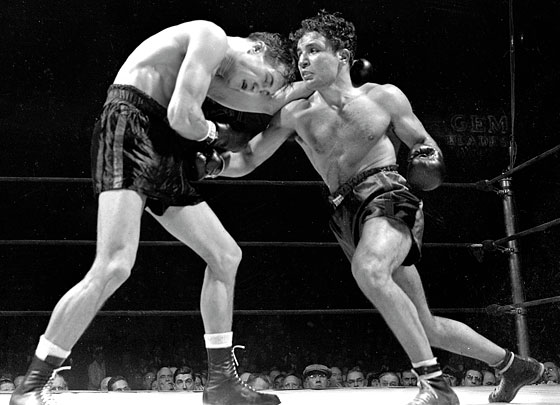
Photo by NY Daily News Archives/Getty Images
Birthplace: Lawrenceville, Pennsylvania
Professional Career: 1931-1949
Ferdinand Henry John Zivicic was one of five brothers and born to a Croatian father and Slovenian mother on May 8, 1913 just about a year before the outbreak of World War 1, Death Valley hit a scorching 135 degrees and New York’s Grand Central Station reopened as the world’s largest train station.
John Zivic began professionally turning opponent’s faces red, white, black and blue at the age of 18 in Pittsburgh with a first-round stoppage of Al Rettinger. He continued fighting at a pace of about once per month, sometimes more for the duration of his 18 year career.
“The Croat Cornet” was prone to his own loose interpretation of the rules often employing the gloves laces and thumbs as well as his own head and elbows to maximize the damage to his rival. Even if they were able to escape with a victory, it would not come without a price. Interestingly, Zivic was often known to apologize to his opponents for these indiscretions during the fight.
Zivic became the Welterweight champion of the world when the 4-1 underdog upset all-time great Henry Armstrong. In a close battle Zivic rallied and battered the champion furiously in the 15th round, nearly stopping him to secure the decision and claim the title.
In defense of his title Zivic repeated the feat, this time closing the show and stopping Armstrong in 12 at the famed Madison Square Garden in New York.
Through his career, Zivic faced the very toughest fighters his era had to offer, often multiple times. Aside from Henry Armstrong he also took on such notables as Lou Ambers, Sugar Ray Robinson, Lew Jenkins, Billy Conn, Charley Burley, Jake LaMotta, Sammy Angott, Bob Montgomery and Beau Jack
Greatest rival: Zivic’s greatest rivalry was with Henry Armstrong against whom he won two of their trilogy. He also faced off with Jake LaMotta four times.
6. Carmen Basilio
56-16-7, 27 KOs
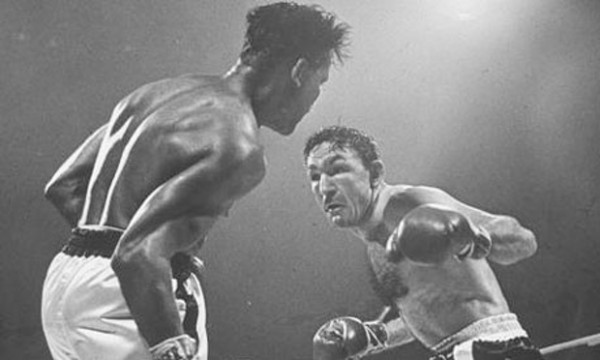
Photo by George Silk/Time & Life Pictures/Getty Images
Birthplace: Canastota, New York
Professional Career: 1948-1961
Carmine Basilio was born in February of 1927. It was the same year that famed pilot Charles Lindbergh flew the first non-stop flight from New York to Paris, The Flatheads Gang committed the first armored car robbery and U.S. President Calvin Coolidge announced that he will not seek re-election.
The Upstate Onion Farmer turned professional with a third-round knockout of Jimmy Evans and just five days later won his second professional fight.
This set the tempo for the tough Italian American fought virtually every month and often several times per month despite the soreness and injuries that accompany such frequency.
In 1949 Carmen Basilio went 11-2-2, 6 KOs as he hooked, jabbed and mauled his way through his advisories, fighting for his opportunity to climb the welterweight ranks.
The very next year fortune smiled on Basilio who was 18-2-2 when he defeated the former world lightweight champion Lew Jenkins via 10 round majority decision. Jenkins was a veteran of 117 bouts including bouts against legends such as Henry Armstrong, Bob Montgomery, Ike Williams, Fritzie Zivic, Marty Servo, Lou Ambers and more.
The experience Basilio inevitably gained served him well as he pressed forward and in 1953 had positioned himself for a fight with welterweight champion of the world, Kid Gavilan.
In the second round Basilio dropped The Cuban Hawk for just the second time in his long career, forcing him to take the count of nine. Gavilan recovered, fought back fiercely and barely retained his title by a narrow 15 round split decision.
Basilio went unbeaten over his next 11 fight culminating with a 10 round unanimous decision over Peter Mueller that made him the number one contender and positioned him for another opportunity at the crown.
In 1955 Basilio stopped the tough, New England bred Tony DeMarco in 12 rounds, finally achieving his goal of welterweight supremacy.
Within five months Basilio won two more fights and granted DeMarco a rematch in his hometown of Boston, MA. He dropped DeMarco twice in a wild shoot out to retain his title in a fight that was voted Ring Magazine’s Fight of the Year.
In his next bout Basilio lost a controversial 15 round unanimous to Johnny Saxton who was manager by famous Mafioso Frank “Blinky” Palermo. So unpopular was the decision that those in attendance booed for more than five minutes after it was announced. Palermo and his partner Frankie Carbo were later incarcerated for fixing fights.
In an immediate rematch, Basilio kept the decision out of the hands of the judges stopping Saxton in nine rounds in what was voted Ring Magazine’s 1956 Fight of the Year and reclaiming the championship.
He stopped Saxton in two in a rubber match, removing any doubt of ring superiority.
In 1957 the ever ambitious Basilio moved up to middleweight to challenge the all-time great Sugar Ray Robinson in, once again, Ring Magazine’s Fight of the Year, to become champion in a second weight division by 15 round split decision.
Complying with the rules at the time Basilio relinquished his welterweight championship to pursue his fortunes in the 160 pound division.
This is where Basilio’s story as a middleweight begins with his legacy as one of the great American welterweights secure.
Greatest rival: As it would turn out his greatest rivalry would be at middleweight with Sugar Ray Robinson. His greatest welterweight rivalry was against Billy Graham against who he was 1-1-1.
5. Thomas Hearns
61-5-1, 48 KOs
Birthplace: Memphis, Tennessee
Professional Career: 1977-2006
1958 in America was an exciting time that gave birth to a number of icons that are permanently woven into the patchwork of American culture such as the hula hoop, the Chevrolet Impala, The Jolly Green Giant, Friskies Dry Cat Food, Kellogg’s Cocoa Krispies, the Grammy Awards and Thomas “Hit Man” Hearns.
There has been a debate as old as the sweet science itself that revolves around the question of a fighters punching power and if it is a matter of “nurture versus nature” or more simply put, “are punchers born or made?”
Thomas Hearns adds a definitive wrinkle into the conversational fabric that cannot be ironed out.
Hearns had an excellent amateur career compiling a record of (155-8, 11 KOs) winning a number of championships including the National Golden Gloves at light welterweight in 1977.
Also in 1977, Hearns began working with legendary trainer Emanuel Steward and turned professional with 17 straight knockouts. Point: nurture.
Regardless with which side of the argument one may align, what cannot be debated is the devastation that Hearns rained upon his opponents with his 18th victim Alfonso Haymon being the first to hear the final bell though taking a sustained beating for his effort.
The rangy 6’1″ Hearns continued to lay waste to the 147 pounder’s as he went 10-0, 9 KOs over the next 13 months, emphatically making his case to challenge WBA world welterweight champion and future Hall of Famer Pipino Cuevas.
In 1980 Cuevas was just beginning his fifth year as champion with 10 successful title defenses and Hearns was eager to bring his impressive streak to an end.
In the first round of the highly anticipated bout Hearns ripped the champion with jolting right hands and speared him with his long jab, easily winning the round.
The end came dramatically in round two when Hearns landed a titanic right hand to Cuevas’ head. With his feet seemingly rooted in the canvas the champion weaved back and forth drunkenly at the knees for two full seconds before a ruthless follow-up right hand that immediately cratered Cuevas into the canvas.
Cuevas somehow struggled to his feet but the fight was wisely stopped awarding Hearns his first of six world titles in five weight divisions against four Hall of Fame titleholders.
Hearns defended his title three times winning all by knockout before challenging Olympic Gold Medalist, media darling and WBC/WBA welterweight champion “Sugar” Ray Leonard 30-1 (22) in a unification fight for the ages with the winner claiming absolute welterweight supremacy.
Hearns entered the ring in front of a sellout crowd of 23,618 with an imposing record of 32-0 (30) for the superfight billed as The Showdown in which he and Leonard shared a combined 17 million dollars, a record at the time.
The fight lived up to the buildup and in a strange reversal of roles Hearns played the part of skillful boxer with Leonard stalking, looking to open up as the puncher.
The strategy was largely successful as Hearns continued to pile up the points round after round leaving Leonard searching for answers. Leonard’s left eye was slowly swelling closed and by the end of the 12th and things were going Hearn’s way though not without a couple anxious moments.
In the 13th round Hearns was caught by a Leonard right hand and was clearly hurt. Not giving Hearns a chance to recover Leonard swarmed furiously, eventually forcing the referee to stop the fight with Hearns dangling in the ropes.
It was Hearns’ last fight as a welterweight and Fight of the Year, considered by many to be one of the all-time great championship fights.
With Hearns’ 147 pound legacy firmly established, he moved up in weight and campaigned for many more years in multiple weight classes, providing fans with a level of drama and entertainment that will not be forgotten.
Greatest rival: His greatest rivalry was with Sugar Ray Leonard who he pursued into the Super Middleweight division. He finally got the rematch that he was chasing and it was controversially judged a draw despite dropping Leonard twice. Leonard himself later admitted that Hearns deserved the decision.
4. Barney Ross
72-4-3, 22 KOs
Birthplace: NewYork City, NY
Professional Career: 1929-1938
1909 was a big year as the genesis of many things that will develop and become part of everyday life for generations to come. The Queensboro Bridge was opened linking Manhattan and Queens, the first Lincoln head pennies were minted, workers began pouring concrete to build the Panama Canal and Orville Wright tested the 1st U.S. Army airplane. It also began several sports legends as Ty Cobb hit two in the park home runs, the Boston Red Sox traded 41 year old Cy Young to the Cleveland Naps and Dov-Ber Rasofsky was born.
He is better known as Barney Ross.
Ross has as amazing an American story that has been ever told.
He was a first generation American when his parents barely survived the organized massacre of Jews in Eastern Europe to immigrate to New York. They then moved to Chicago where they opened a small vegetable store in the Jewish ghetto of the Maxwell Street neighborhood.
Ross’ father was a Rabbi very opposed to fighting and violence and wanted him to follow in his footsteps. Ross himself planned to become a Jewish teacher and Talmudic scholar until his life took an irrevocable and tragic turn when his father was shot dead while his store was being robbed.
His Mother was overcome with a grief so devastating that his siblings were sent to orphanages and extended family while Ross was left to fend for himself at age 14.
With his world turned upside down and rage filling his young heart he turned his back on the ordained religion of his father and began running the streets with other urchins. He developed into a thief, street brawler and money runner even working for famed mobster Al Capone with the ultimate goal of assembling enough money to reunite his family.
Ross found boxing and it was at this time that he changed his name so that he would not dishonor his father or bring shame on his birth name by fighting which was completely counter to the way he was raised.
Shortly after turning professional Ross began gaining popularity with is iron will, style and tenacity. It is rumored that early in his career Al Capone would purchase blocks of tickets for Ross’ fights knowing that it would help him make some money and help him along his way.
Not only was Barney Ross on the rise but so was Nazi leader Adolf Hitler who heavily promoted anti- Semitic propaganda to further his stranglehold and this made Ross a hero to the Jews and a symbol of strength, freedom and success in the face of evil.
Ross battled his way through the lightweight and light welterweight divisions, winning the world championship in both classes.
Amazingly, in 1935 and his very first fight in the 147 pound division he challenged future Hall of Famer Jimmy McLarin for the welterweight championship of the world.
At the Madison Square Garden Bowl in Queens, NY Ross became the welterweight champion in front on 60,000 screaming fans in attendance via 15 round split decision and one of the very first triple champions in boxing history.
Ross lost the title back to McLarin in an immediate rematch via 15 round split decision, dropped back down in weight to reclaim his light welterweight crown with a decision over Bobby Pacho and in 1935 challenged McLarin again for the welterweight championship in a rubber match.
This time in front of a crowd of 35,000 and with legendary heavyweight champion Jack Dempsey as the referee, Ross regained the welterweight crown with a 15 round unanimous decision.
Ross was determined to hold on to his championship and won his next 17 fights including Baby Joe Gans and three victories over Ceferino Garcia among others.
In his final fight Ross was dethroned in a one sided beating by a prime, all-time great Henry Armstrong. During the fight there were calls for the fight to be stopped but Ross strongly protested against his corner and finished the fight on his feet having never been stopped in 79 professional fights.
His story continues with World War II heroics and overcoming a serious morphine (heroin) addiction as a result of his wounds.
He ultimately accomplished his life’s goal and successfully reunited his family.
Greatest rival: His greatest rival was Jimmy McLarin with whom he was 2-1 in world welterweight championship contests.
3. Sugar Ray Leonard
36-3-1, 25 KOs
Birthplace: Wilmington, NC
Professional Career: 1977-1997
If your heart was broken Elvis Presley would be able to direct you to a hotel where you may properly sleep it off in 1956. It was the same year the singer had his first television appearance and his songs Don’t Be Cruel and Hound Dog hit the top of the charts for a record 11 weeks. The Wizard of Oz was televised for the first time, Martin Luther King Jr’s house was firebombed and New York Yankee Mickey Mantle homered from both sides of the plate for the third time in his career….and then there is Ray Charles Leonard.
Fighters as special as Sugar Ray Leonard don’t come around very often and he is number three of all time even if this list was not exclusively American.
He was the fifth of seven children who grew up as an ordinary, shy child with both parents working and providing for their family. Like many regular children Leonard enjoyed reading comic books, playing with the family dog and doing ordinary, average kid things.
Perhaps there is a certain wisdom in the saying “still waters run deep” as despite his placid exterior as a youth in his chest beat the heart of a champion.
Leonard’s brother Roger helped start a boxing program at a local recreational center and after winning several trophies antagonized his brother as brothers do, drawing Leonard into a trajectory that would change not only Ray Leonard’s life but the history of welterweight boxing from that time forward.
As an amateur Leonard had no intention of turning professional until life dealt him some unexpected blows as life tends to do.
Shortly before the Olympics his high school girlfriend named Leonard as the father and filed a paternity suit for child support. Leonard immediately determined that he would take responsibility and be a father to his child regardless of sacrificing boxing and college should it be necessary. This had an unfortunate backlash and Leonard was unable to secure substantial endorsement contracts.
Leonard had a stellar amateur career that came to an apex with a gold medal for the United States in the 1976 Olympics. Still, the aforementioned stigma remained.
Adding to his problems his mother suffered a heart attack and as timing would have it his father fell ill and was hospitalized with meningitis. Without a meaningful way to substantially provide for his family outside of the obvious, Leonard turned pro in 1977.
Being a Gold Medal winning, charismatic fighter had its perks and Leonard made $40,044 winning a six round decision in his professional debut. This was a glaring contrast of his opponent Luis Vega who made $650. This would be consistent as Leonard was the first fighter to earn over $100 million dollars.
Interestingly, Leonard has the least professional fights of any on this list yet the spotlight was positioned directly in Leonard’s face as much as any fighter in history. Leonard is a unique case of concentrated greatness; he is a boxer who made more of an impact in 40 fights than most in a lifetime.
At 25-0 Leonard challenged the likewise undefeated and youngest man to win a world championship at just 17 years old, Wilfredo Benitez 38-0-1. It was a competitive fight though Leonard was not in danger of losing at any point, dropping Benitez in the third who rose more embarrassed than hurt in the third round. At the end of the night Benitez had is his first pro loss and Leonard had his first pro world championship.
Leonard defended his title with a highlight reel stoppage of Danny “Boy” Green before accepting the challenge of the most dangerous contender and fellow all-time great and former lightweight world champion Roberto Duran 71-1 (57).
Duran successfully got into Leonard’s head by insulting his wife and disrespecting him at every opportunity, demeaning Leonard with impunity whenever they were within spitting distance.
Despite the pleas from Hall of Fame trainer Angelo Dundee Leonard dug his heels in and was absolutely determined to defeat the Panamanian bully at his own game. Instead of employing his usual slick boxer/puncher style Leonard elected to engage the dangerous Duran at his own game and paid the price losing a close 15 round decision.
Three months later Leonard embarrassed the macho Duran with superior boxing and taunting skills, perhaps because Duran was enjoying an extended celebration when offered the big money rematch.
Duran was thoroughly outboxed and perhaps more than a little humiliated and having his legendary machismo challenged by Leonard’s taunting waived his gloves conceding to Leonard uttering “No mas, no mas” which he denies uttering to this day.
Just two defenses later Leonard accepted the challenge of fellow Hall of Fame and all-time great furthering his highly concentrated legacy against the undefeated, terrifying Thomas “Hit Man” Hearns 32-0 (30).
The lanky 6’1 “Hit Man” surprisingly assumed the role as the matador to Leonard’s bull and did so with great success. Hearns dictated the tempo for the majority of the fight until Leonard made the proper adjustment and hurt Hearns in the 11th.
From that point forward Leonard hunted while his eye swelled shut with an injury that would alter his career from this point forward.
Leonard finally put Hearns in the position that he had invested 13 ½ rounds when he sent the lanky destroyer into a confusing tangle of long limbs and ropes that became ensnared as Leonard finished the fatigued Hearns and referee Davey Pearl called a halt to the 1981 Fight of the Year.
It is here that Leonard’s significant welterweight contributions end though as most reading this article knows his achievements went far deeper in a legendary career.
Greatest rival: Duran is a runner up but as a welterweight there was no more dangerous opponent that Thomas Hearns.
2. Henry Armstrong
151-21-9, 101 KOs
Birthplace: Columbus, MS
Professional Career: 1931-1945
“Homicide Hank” is not the first fighter on this list born in 1909 (some say 1912) but he is certainly the best.
Theodore Roosevelt who is the only three term U.S. President, former boxer and friend of legendary John L. Sullivan turned the keys of the country over to polar opposite 27th president William Howard Taft, the U.S. Navy founded a base in Pearl Harbor, HI and the Manhattan Bridge was opened.
Henry Armstrong turned professional in 1931 at the age of 21 and lost three of his first four fights. In today’s Instaworld where soundbites, selfies and social media ridiculously determine a fighter’s future and somehow define their legacy he would have been doomed from the beginning. What we received in fact is arguably the second greatest fighter to ever lace a pair of gloves. Yes, they used to lace their gloves.
Armstrong was a world champion in three of only eight weight classes at the same time. No, “silver” championship, no WBA this or WBC that..simply world champion. He was an I will step in the ring, no catchweight, no rehydration and no politics, “lets fight” fighter.
He was tough in the toughest of times and became great in a time of greats as his tireless, volume punching, aggressive style won fans and championships. Armstrong was truly one that would have to be seen to be believed.
In 1937 Armstrong reeled off 22 wins with 21 knockouts before claiming the featherweight championship with a six round stoppage victory over Petey Sarron.
Approximately six months later Armstrong challenged all-time great Barney Ross for the welterweight championship of the world and left with the belt after pounding the massively courageous Ross for 15 rounds.
In his very next fight Armstrong dropped down to lightweight to relieve Lou Ambers of his world championship in one of the greatest title fights in history via 15 round split decision despite being penalized four rounds for fouls.
In a span of just 10 months Armstrong had annexed the featherweight, lightweight and welterweight titles and held them all concurrently.
He returned to welterweight in his next fight to successfully fend off the challenge of Hall of Famer Ceferino Garcia despite weighing in at only 134 pounds, the same weight at which he won the lightweight championship.
Garcia was the first of seven welterweight defenses before the multi-tasking Armstrong finally released his grip on the lightweight title in a return match with former champion Lou Ambers.
In October of 1939 the ever energetic Armstrong successfully defended his welterweight championship five more times in just 21 days.
Armstrong ultimately defended his welterweight crown almost 20 times before relinquishing it to fellow Hall of Famer and 132 fight veteran Fritzie Zivic.
While Armstrong never regained the welterweight championship he continued to campaign and engaged in another 50 fights at the 147 pound limit including a clash with Sugar Ray Robinson which featured arguably the two best fighters in history. Robinson won a 10 round decision.
It is said that upon Armstrong’s death that it was discovered that his heart was a third larger than the average man’s which allowed him to consistently fight at his famously furious pace without the fatigue because of the extra oxygen it provided to his bloodstream.
Whether biological fact or popular pulp fiction, Armstrong’s endurance and swarming style made him a three division champion, fan favorite and all-time great.
Greatest rival: This is a tough one but it is likely Fritzie Zivic who defeated Armstrong twice in championship fights.
1. Sugar Ray Robinson
173-19-6, 108 KOs
Birthplace: Alley, GA
Professional career: 1940-1965
In 1921 the New York Yankees purchased 20 acres in the Bronx to build Yankee Stadium, Babe Ruth became the home run king with number 120, Ty Cobb was the fourth player to get 3,000 hits and the greatest fighter pound for pound, Walker Smith Jr. was born.
Walker Smith Jr. got his start as an amateur when attempting to enter his first tournament he was unable to attain an AAU membership and borrowed the name of Ray Robinson who was not present, but had an active license. He finished his amateur career at 85-0, 69 KOs with 40 of those knockouts coming in the first round.
Robinson turned pro in 1941 and won his first 40 bouts including a pair of massacres of Fritzie Zivic until meeting The Bronx Bull Jake LaMotta who bullied Robinson through the ropes in the eighth round and took a 10 round unanimous decision.
By 1943 Robinson had won 73 fights cleaning out the 147 pound division’s top contenders with his solitary welterweight loss to LaMotta but was unable to secure a title shot because he was unwilling to work with the Mafia who largely controlled boxing at the time.
In 1946 the persistent and undeniable talent that was Robinson got his chance and challenged Tommy Bell for the title that had been vacated by Marty Servo. Robinson was dropped in the melee but emerged as the winner and new welterweight champion.
Continuing his unprecedented tear through the welterweights Robinson had a unique experience. Prior to his fight against Jimmy Doyle Robinson had a premonition in the form of a dream that he killed Doyle in the ring. Frightened, he sought religious counsel and tried to back out of the fight but was convinced by parishioners otherwise.
Robinsons fear became a reality after knocking Doyle out in the eighth round his opponent slipped in to a coma and died.
Amazingly, charges of manslaughter were filed against Robinson though justice prevailed and nothing materialized.
After learning that Doyle intended to buy his mother a house with his earnings Robinson purchased the house for her in his honor.
In 1948 Robinson fought 5 times including a savage war with Kid Gavilan, an All-Time great from Cuba against whom he was awarded a close 10 round decision.
In 1950 Robinson reeled off 19 more wins at welterweight before advancing to middleweight where he became a five time champion, further cementing his legacy as an absolute icon of boxing.
Robinson is generally accepted as pound for pound the greatest fighter to step foot in a ring.
Greatest rival: Jake LaMotta, the first to defeat Robinson in the first of their five fights with the rest coming at middleweight. LaMotta once commented that he fought Sugar Ray so many times he was surprised he didn’t develop diabetes.
